#primatology
Text
Apes are a kind of monkey, and that's ok
This is a pet peeve of mine in sci comm ESPECIALLY because many well respected scientific institutions are insistent about apes and monkeys being separate things, despite how it's been established for nearly a century that apes are just a specific kind of monkey.
Nearly every zoo I've visited that houses apes has a sign somewhere like the one below that explains the supposed distinction between the two groups, focusing on anatomy instead of phylogeny.

(Every time I see a graphic like this I age ten years)
Movies even do this, especially when they want to sound credible. Take this scene from Rise of the Planet of the Apes:
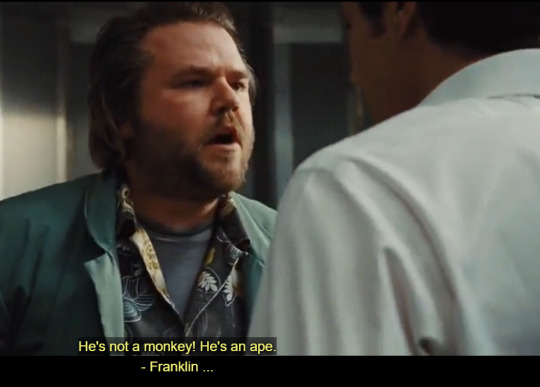
This guy Franklin is presented as the authority on apes in this scene, and he treats James Franco calling a chimpanzee a monkey like it's insulting.
But when you actually look at a primate family tree, you can see that apes are on the same branch as Old World monkeys, while New World monkeys branched off much earlier.

(I'm assuming bushbabies are included as "lorises" here?)
To put it simply, that means you and I are more closely related to a baboon than a baboon is to a capuchin.
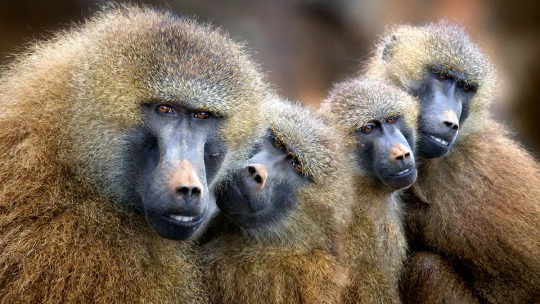
Either the definition of monkey includes apes OR we can keep using an anatomical definition and Barbary macaques get to be an ape because they're tailless.

"I've got no tails on me!"
SO
Why did all this happen? Why did we start insisting apes are monkeys, especially considering the two words were pretty much interchangeable for centuries? Well I've got one word for ya...

This the attitude that puts humans on a pedestal over other life on Earth. That there are intrinsically important features of humanity, and other living things are simply stepping stones in that direction.
At the dawn of evolutionary study, anthropocentrism was enforced by using a model called evolutionary grades. And boy howdy do I hate evolutionary grades.
Basically, a grade is a way of defining a group of animals by using anatomical "complexity". It's the idea that evolution has milestones of importance that, once reached, makes an organism into a new kind of thing. You can almost think of it like evolutionary levels. An animal "levels up" once it gains a certain trait deemed "complex".
You can probably see the issue here; that complexity is an ephemeral idea defined through subjectivity, rather than based off anything truly observable. What makes walking on 2 legs more complex than walking on four? How are tails less complex than no tails? "Complexity" in this context is unmeasurable, therefore it is unscientific. That's why evolutionary grades suck and I never want to look at one.
For primates, this meant once some of them lost their tails, grew bigger brains, and started brachiating instead of leaping, they simply "leveled up" and became apes. Despite the early recognition that apes were simply a branch of the Old World monkey family tree (1785!), the idea of grades took precedent over the phylogenetic link.
In the early years of primatology, humans were even seen as a grade "above" apes, related but separated by our upright stance and supposed far greater intelligence (this was before other apes were recognized tool users).

It wasn't until the goddamn 1970s that it was recognized all great apes should be included in the clade Hominidae alongside humanity. This was a major shift in thinking, and required not just science, but the public, to recognize just how close we are to other living species. It seems like this change has, thankfully, happened and most institutions and science respecting folks have accepted this fact. Those who don't accept it tend to have a lot more issues with science than only accepting humans as apes.

And now, we come to the current problem. Why is there a persistent idea that monkeys and apes are separate?
I want to make it clear I don't believe there was a conscious movement at play here. I think there's a lot of things going on, but there isn't some anti-monkey lobby that is hiding the truth. I think the problem is more complicated and deals with how human brains and human culture often struggle to do too many changes at once.
Now, I haven't seen any studies on this topic, so everything I say going forward is based on my own experience of how people react to learning apes (and therefore, humans) are monkeys.
First off, there is a lot of mental rearranging you have to do to accept humans as monkeys. First you, gotta accept humans as apes, then you have to stop thinking in grades and look at the family tree. Then you have to accept that apes are on the Old World monkey branch, separate from the New World monkeys.
That's a lot of steps, and I've seen science-minded zoo educators struggle with that much mental rearranging. And even while they accept this to an extent, they often find it even harder to communicate these ideas to the public.
I think this is a big reason why zoos and museums often push this idea the hardest. Convincing the public humans are apes is already a challenge, teaching them that all apes are monkeys at the same time might seem impossible.
I believe the other big reason people cling to the "apes-aren't-monkeys" idea is that it still allows for that extra bit of comforting anthropocentrism. Think of it this way; anthropocentrism puts humans on a pedestal. When you learn that humans are apes, you can either remove the pedestal and place humans with other animals, OR, you can place the apes up on the pedestal with humanity. For those that have an anthropocentric worldview, it can actually be easier to "uplift" the apes than ditch the pedestal.
Too make things worse, monkeys are such a symbol of a "primitive" animal nature that many can't accept raising them to the "level" of humanity, but removing the pedestal altogether is equally painful. So they hold tight to an outdated idea despite all the evidence. This is why there's often offense taken when an ape is called a monkey. It's tantamount to someone calling you a monkey, and that's too much of a challenge to anthropocentrism.
Personally, I think recognizing myself as a monkey is wonderful. Non-ape monkeys are as "complex" as any ape. They make tools, they have dynamic social groups, they're adapted to a wide range of environments, AND they have the best hair of all primates.
I think we should be honored to be considered one of them.



3K notes
·
View notes
Text
"Isn't it weird when an anthro dog furry meets a real dog? How does that make sense? How can both exist? Wouldn't it make them feel weird?"
Well humans are apes, right? If you asked an anthro creature that question they would probably counter with the old "That's like asking if humans evolved from apes why are there still apes."
Does being around apes make us feel weird? That's actually an interesting question, because when I have seen them at the zoo I have often got a weird feeling. Their expressions and body language are way more dynamic than most nonhuman animals. Of course that's just what you'd expect from our closest living relatives, and research shows we may have a genetic memory of the meaning of apes' common body language.
I think it's probably their expressiveness messing with our expectations around body language that can cause us to have a weird feeling around nonhuman apes, but I think it's a good idea to explore that kind of feeling, and maybe it can even help us understand our place in the world and build empathy with nonhuman animals. Look at this! Those are just some guys! It's just we came down from the trees on two legs, and they came down on all fours.
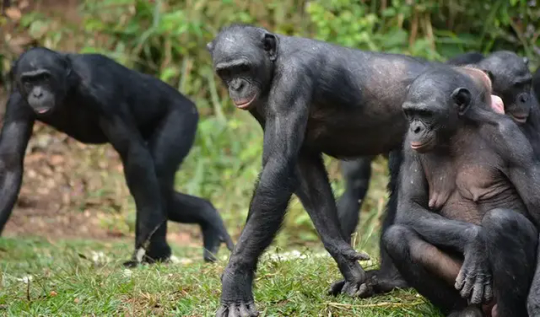
Other posts have said it but genuinely internalizing that I am just an animal and have the needs of one is helping my mental health and understanding of myself.
1K notes
·
View notes
Text
#this poll is my masterpiece i spent so long thinking of appropriate adjectives#we would be like an orangutan#primates#apes#great apes#gorilla#chimpanzee#bonobo#poll#primatology#anthropology#gibbon
359 notes
·
View notes
Text
"[There is] fantastic news for species conservation after new populations of the gorgeous ‘Skywalker’ gibbon, known to science for only 6 years, were recently found living in the politically chaotic nation of Myanmar.
Also called the hoolock gibbon, this dainty vocalist was first described in 2017 living in the extreme south of China on a mountain in Yunnan. Classified as Endangered by the IUCN, the population was estimated to number a paltry 150 individuals, but others were believed to live in Myanmar.
Even before the recent military junta usurped the president and plunged the country into civil war, Myanmar [was a difficult place to conduct field studies, especially extensive or ongoing ones, due to ongoing conflict.]
[Although they are] now in open revolt against the military junta, [the Myanmar states of Shan and Kachin] were nevertheless destinations for an intrepid team of scientists from the Nature Conservation Society Myanmar, Fauna & Flora International–Myanmar Programme, the IUCN’s ape specialist group, and field researchers from universities in England, China, and the US.
Together, they conducted acoustic surveys, collected non-invasive DNA sampling, and took photographs for morphological identification at six sites in Kachin State and three sites in Shan State. With the help of the Myanmar conservationists, the team also interviewed locals dwelling in rural forested areas, small conservation programs, and timber companies about the frequency of sightings and the hunting pressure.
Population estimates of unknown quality and scientific rigor conducted in 2013 suggested there might be 65,000 hoolock gibbons in Myanmar, but the matter became much more complicated after the classification of the Skywalker gibbon as a separate species from the eastern hoolock gibbon—where before they were confused as the same.
“We were able to genetically identify 44 new groups of Skywalker gibbons in Myanmar,” said senior author Tierra Smiley Evans, research faculty at the UC Davis School of Veterinary Medicine, and contributing author. “This is a huge resource and success story for Myanmar.”
These gibbons sing to each other at dawn for around 22 minutes, and consume 36 different plant species; choosing fruit first, and flowers later. They seldom sleep in the same tree two nights in a row to avoid predation, and can’t swim so are often confined to territories by river systems.
The team that discovered them in China in 2017 loved Star Wars, and called them tianxing which is Chinese pinyin for “heaven movement;” a nod not only to their favorite sci-fi franchise, but also to China’s ancient history. In the famous Book of Change [aka the I Ching] of the Zhou Dynasty [1046 BCE to 265 BCE], a divination poem refers to gibbons specifically, and uses tianxing as a verb to describe their movements.
The interviews were a source of great data for the scientists. For starters, nearly all individuals in both the Kachin and Shan states could identify a Skywalker gibbon by sight and by playback of its singing, lending the exercise a good degree of reliability...
“Biologists did not believe Skywalker gibbons could live in the small remaining patches in Southern Shan State before we started this project,” Pyae Phyo Aung, executive director of Nature Conservation Society Myanmar, told the UC Davis press.
“I am delighted with our field team members who have done an excellent job, within a short period of time, building community trust for further conservation actions. This area is degraded forest. It is really important for Myanmar and China to consider extending conservation approaches for the Skywalker gibbon to this new geographic area.”
Nearly 32,000 square kilometers, or around 8 million acres of forestland in Eastern Myanmar are suitable gibbon habitat, and while existing forest reserves like Paung Taung and Mae Nei Laung are quite large, they remain unprotected. For this reason, the survey team recommended they remain considered ‘Endangered’ on the IUCN Red List until habitat protections improve."
-via Good News Network, February 21, 2024
#gibbon#apes#primates#myanmar#endangered species#china#zoology#conservation biology#conservation news#primatology#good news#hope
148 notes
·
View notes
Text
ppl only debate on if archaeology and anthropology are stem bc they don’t see humans as animals. But anthropology is just a specific offset of primatology. Humans are just animals in the end. I mean they happen to be my favorite species of animal which is why I’m so interested in studying how they evolved and interacted (and contribute to interact) w da world. But yeah end of the day it’s just animal science yk. Uhhhhhh yeahToday is my first day on earth
45 notes
·
View notes
Note
Your tags about the marmoset -- so the owner had HSV-1, which is endemic in humans and always present after a human gets infected and pretty much harmless except for the cold sores, and the monkey caught it from her and was dying?
How do zoos manage this stuff? Do human keepers always have to mask and glove up when handling any monkey?
Essentially, yep. My current research involves herpesviruses and I could talk for days about how they are the smartest virus. They have evolved with vertebrates for so long that many of them are extraordinarily host-specific. A herpesvirus that causes no symptoms in a pigeon can cause fatal organ necrosis in a great horned owl. This concern absolutely exists in primatology as well. There are subclinical herpesviruses in monkeys and apes that can kill a person, and our herpes can be dangerous to them as well. This is why contact with primates in zoos is very strictly regulated; it’s for everyone’s safety. In 2016 a zoo in Israel lost an entire family of saki monkeys to HSV-1.
In the veterinary setting, we always wear at least mask and gloves when interacting with any primate. It is important to note however that some primate species are far more susceptible to human herpesvirus infection than others, and the risk level is not the same across all primates.
#primatology#herpesvirus#zoology#the farther the phylogenetic host jump the worse the disease#<- that’s a little reductive but essentially accurate
154 notes
·
View notes
Text
fun fact! teco the bonobo has achieved flight! he is currently the only known flying bonobo
here he is in action:

74 notes
·
View notes
Photo

Jane Goodall was born on April 3, 1934. An English primatologist and anthropologist. Seen as the world's foremost expert on chimpanzees, Goodall is best known for her 60-year study of social and family interactions of wild chimpanzees since she first went to Gombe Stream National Park in Tanzania in 1960, where she witnessed human-like behaviors amongst chimpanzees, including armed conflict.
#jane goodall#chimpanzees#anthropology#primatology#women in history#women in science#science#science history#science birthdays#on this day#on this day in science history
185 notes
·
View notes
Note
Is primatology a dead field? I wanna get into it but I'm worried it's not something people are after anymore
I’m sorry, I really don’t know anything about the field of primatology, but I’m sure it’s still worth pursuing! Any primatologists want to chime in?
20 notes
·
View notes
Text

Barbary Macaque (Macaca sylvanus)
Family: "Old-World" Monkey Family (Cercopithecidae)
IUCN Conservation Status: Endangered
Distinguished from other macaques by their thick grey or brown fur and extremely short tails (which measure only around 2-3cm/0.7-1.9 inches in length, and are easily missed,) Barbary Macaques are native to cool, mountainous regions of Morocco and Algeria, but are also present as an invasive species on the European island of Gibraltar (making this species the only non-human primate living wild in Europe.) Favouring cedar forest habitats, members of this species live in large mixed-sex troops led by a dominant female; females inherit their rank from their mothers (with the largest, strongest daughter of the dominant female becoming the troop’s leader following her mother’s passing) while males form a separate hierarchy with larger, older individuals at the top. Barbary Macaques breed between November and December and are noted to be highly promiscuous, with both sexes seeking out several mates in a single season (so much so that in small troops it is possible that every unrelated adult in the group will eventually mate with one another,) and when females give birth in the following spring every member of the group, including males and females that did not mate in the previous season, will contribute to carrying, feeding, teaching and protecting the young - male parental care is rare in other macaque species, but it has been suggested that, as male Barbary Macaques have no way of knowing which, if any, of the young born each year are theirs they become invested in the wellbeing of all of them (studies into interactions between males and infants suggests that they may even have “favourite children”, which they play with more often than other infants in the troop.) Like other macaques, Barbary Macaques are diurnal and spend much of the day foraging on the ground, feeding on nuts, fruits, roots, mushrooms, insects and small vertebrates such as frogs; when foraging they frantically stuff food into pouches in their cheeks to be swallowed later while at least one member of the troop remains on “sentry duty” surveying their surroundings and releasing a harsh alarm call at the first sign of predators (such as Golden Jackals or large birds-of-prey,) encouraging their troop-mates to take cover in the lower canopy of nearby trees.
--------------------------------------------------------------------------
Image Source: https://www.inaturalist.org/taxa/43452-Macaca-sylvanus
#Barbary Macaque#barbary macaque#macaque#macaques#monkey#monkeys#zoology#biology#mammalogy#primatology#animal#animals#wildlife#African wildlife#European wildlife#mammal#mammals#primate#primates
50 notes
·
View notes
Text
De Brazza's monkey

Sumatran orangutan

Mandrill

Emperor tamarin
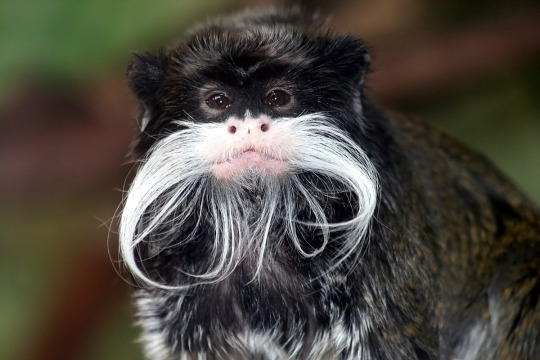
Grey-shanked douc

Lion-tailed macaque

Lesser spot-nosed guenon

Moustached tamarin

White-faced saki

Agile gibbon

Common patas monkey
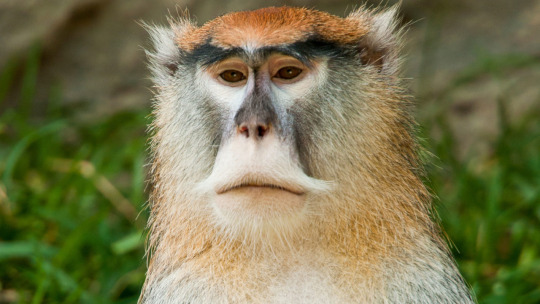
Roloway monkey

851 notes
·
View notes
Text
my brain just read "any given moment" as "any gibbon moment" and I've decided that needs to be a thing now

17 notes
·
View notes
Text

We all need a little cuddle sometimes. <3 Baby chimpanzee faces are lighter in color and they darken into maturity, which you can see in this baby and mama chimp!
Photo ©GEllis/GLOBIO
39 notes
·
View notes
Text

a group of monkeys sitting on top of rocks // Bonobos at the Cincinnati Zoo by Sean Foster. 2021.
#sorry just found this pic and stared at it for like fifteen minutes#THEY ARE SOOOOOOOOOOO SILLY AND CUTE AND EVERYTHING!!!#bonobo#bonobos#primate#primates#primatology#idk what else to tag this LMFAO.
11 notes
·
View notes
Text


Paranthropus Appreciation Post!
What does this cow-like bipedal ape say about what it means to be human?
Paranthropus is a genus of extinct bipedial ape, represented by fossils of three species in west and south Africa around 2 million years ago. It seems like they evolved from earlier bipedal apes called Australopiths, which branched into two groups, Homo, which started eating meat and using tools, and eventually evolved into humans. The name paranthropus even means "Beside man." Paranthropus went in another direction, and filled a cow like niche. It has HUGE teeth compared to other apes, and this means it probably ate grass or nuts, depending on the subspecies. Bigfoot people, if you want to stop appropriating indigenous myths, paranthropus is right there.
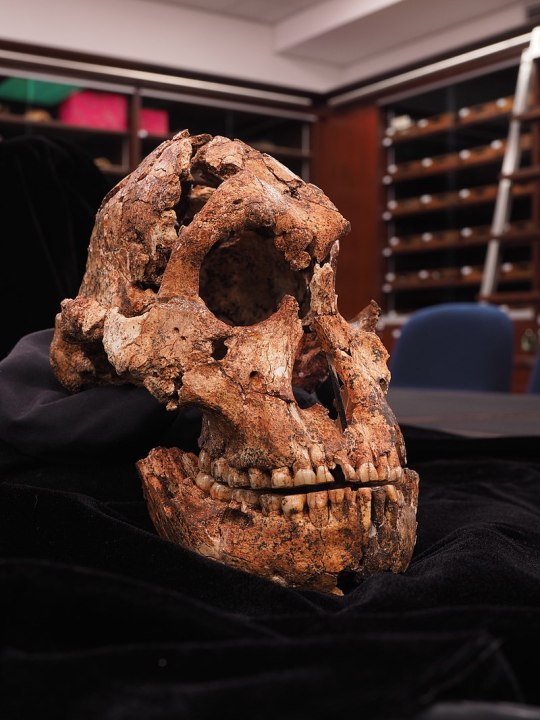
While they are not humans or proto humans, it does raise some interesting questions on what it means to be human. Were they basically just bipedal gorillas, or did they have more going on? They went in a different direction from our hunter gather ancestors, but they did exist in the same time and places. We like to think of using stone tools as something only humans and our ancestors do, but there is a stone tool site that is associated with paranthropus, due to one of their unmistakable teeth being found at the site. This probably means it did eat meat at least sometimes, and used stone tools to butcher carcasses. There was clearly something going on in their minds.

Images of stone tools found associated with paranthropus, including analysis. Source
It may seem surprising that other apes could use flaked stone tools, but most people in the know accept that australopiths, or other similar apes that may be ancestor to both homo and paranthropus could use stone tools, so there's no reason to think it couldn't other than human supremacy.
We have also sequenced proteins from their teeth that shows how closely related they are to humans, and it confirms the time they split from our family.
They are a super cool ape and shows that we are not the inevitable endgoal of human evolution. Anyway, now I have told you about it, I hope to see some paranthropus and other pre-human bipedal ape fursonas. They are the only animals that are truly "anthro", and the fact humans are the only bipedal great ape still alive contributes to human supremacy over animals. Imagine if there were relatives this close to us around today!
#anthropology#paleoanthropology#paranthropus#furry#primatology#apes#primates#history#human history#archeology
16 notes
·
View notes
Text
i know literally nothing else about him so if he's some sort of awful person please disregard but i think françois desbordes deserves one (1) kiss on the mouth for illustrating this book
14 notes
·
View notes